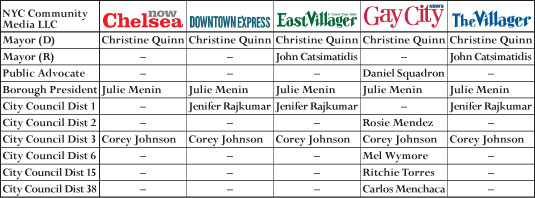The Westside Market is opening a store on Third Avenue between 11th and 12th Streets.

Westside Market on Third Avenue.
Local news sites and bloggers are beside themselves with giddiness, focussing on their family-owned, immigrant, rags-to-riches appeal: the usual Horatio Alger crap.
And eco-friendliness! What new store would be complete without eco-friendliness?
The Westside Market may have risen to its prominence by hard work, but it was the over-worked employees who did it. Over-worked and subjected to unsafe working conditions, such as what killed 20-year-old Raymundo Juarez-Cruz, an immigrant from Mexico, at their Broadway and 110th Street store. Police investigating the death said a safety switch on the compactor had been overridden.
- Patrick Purcell, the director of organizing for Local 1500, the United Food and Commercial Workers International Union, said Mr. Juarez-Cruz’s accident was indicative of the working conditions endured by employees of many nonunion supermarkets.
“These machines are something that you should be working with supervision after being properly trained,” Mr. Purcell said. He said that in stores where the union represents workers, there are clear signs and directions on the compactors.
1* * *
When this same Upper West Side location closed in 2004, the Columbia Spectator wrote about how workers had been treated:
- Modou Dia, who worked at Westside for 17 years, said, “I work 72 hours a week for the last 10 years. I never got no holiday, no sick pay, no overtime, no vacation. No even ‘thank you.’ He no even tell us he gonna close [today].”
Liapat Ali, who worked in the deli section at Westside for 17 years, said, “The store made money from selling expired food. They would repackage things after they expired and resell them. … I’m 51 years old. Where am I gonna go? No pension, no severance, nothing.”
2* * *
Westside Market is not alone in this. The following information is based on a survey of over 100 workers in gourmet grocery stores in Chelsea and the West Village:
- Poverty wages, and no pay increases: The average reported wage was just $7.50 per hour, and cashiers started at $6.50 per hour – that’s $13,000 a year working full-time. The highest wage was $9.00 per hour. At many of the stores, workers did not receive annual pay increases.
Few benefits, if any: Only a few stores offered health benefits. And in the few cases where health insurance was offered, the benefits were too expensive, workers had to be full-time, and had to wait 10-12 months to become eligible.
Long hours and no over-time pay: Full-time workers often had to work up to 60 hours per week – with no overtime pay, a violation of state and federal wages laws. At the same time, many part-time workers wanted more hours but couldn’t get them.
Discrimination: Women, undocumented immigrants, and workers with limited English proficiency earned the least and had to work the hardest.
Little upward mobility: Most of the stores hired their managers from the outside, rather than promoting from within. As a result, entry-level workers were largely black or Latino, while most managers were white.
Abusive working conditions: Breaks were short and infrequent. Almost no store allowed sick days. Sexual harassment, verbal abuse and threats were frequent, especially against immigrants.
3But it’s eco-friendly!
* * *
None of this information was hard to come by. I found it in a short time using Google, while at work, no less! Local news sites and bloggers who take the time to interview the owners certainly have time to interview the workers too. Of course, as I found when interviewing workers at bodegas, they’re reluctant to speak, for fear of losing their jobs. But the bloggers could report this, and they could take the time to find out the working conditions existing in the stores they gush over.
=-=-=-=-=
1Supermarket Worker Is Killed By Cardboard-Box Compactor,
accessed Oct. 3, 2014.
2Westside Market Closes its Doors After 30 Years on Broadway,
accessed Oct. 3, 2014.
3Is your Gourmet Grocery a Sweatshop? A Report on Working Conditions at Upscale Groceries in New York City, accessed on Oct. 4, 2014.








 1
1 1
1
